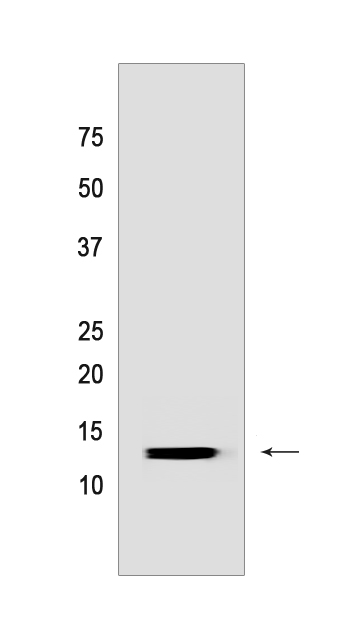Elongin-B Rabbit mAb [BMR6]Cat NO.: A26492
Western blot analysis of extracts from Jurkat cells lyastes.using Elongin-B Rabbit mAb [BMR6] at dilution of 1:1000 incubated at 4℃ over night
Product information
Protein names :ELOB,TCEB2,ELOB_HUMAN,Elongin-B
UniProtID :Q15370
MASS(da) :13,133
MW(kDa) :13 kDa
Form :Liquid
Purification :Protein A purification
Host :Rabbit
Isotype :IgG
sensitivity :Endogenous
Reactivity :Human,Mouse,Rat
- ApplicationDilution
- 免疫印迹(WB)1:1000-2000
- The optimal dilutions should be determined by the end user
Specificity :Antibody is produced by immunizing animals with a synthetic peptide of Human Elongin-B.
Storage :Antibody store in 10 mM PBS, 0.5mg/ml BSA, 50% glycerol. Shipped at 4°C. Store at-20°C or -80°C. Products are valid for one natural year of receipt.Avoid repeated freeze / thaw cycles.
WB Positive detected :Jurkat cells lyastes
Function : SIII, also known as elongin, is a general transcription elongation factor that increases the RNA polymerase II transcription elongation past template-encoded arresting sites. Subunit A is transcriptionally active and its transcription activity is strongly enhanced by binding to the dimeric complex of the SIII regulatory subunits B and C (elongin BC complex) (PubMed:7638163). In embryonic stem cells, the elongin BC complex is recruited by EPOP to Polycomb group (PcG) target genes in order generate genomic region that display both active and repressive chromatin properties, an important feature of pluripotent stem cells (By similarity).., Core component of multiple cullin-RING-based ECS (ElonginB/C-CUL2/5-SOCS-box protein) E3 ubiquitin-protein ligase complexes, which mediate the ubiquitination of target proteins (PubMed:10205047, PubMed:12004076, PubMed:12050673, PubMed:15590694, PubMed:26138980, PubMed:29779948, PubMed:29775578). This includes the von Hippel-Lindau ubiquitination complex CBC(VHL) (PubMed:10205047, PubMed:12004076, PubMed:12050673, PubMed:15590694). By binding to BC-box motifs it seems to link target recruitment subunits, like VHL and members of the SOCS box family, to Cullin/RBX1 modules that activate E2 ubiquitination enzymes (PubMed:10205047, PubMed:12004076, PubMed:12050673, PubMed:15590694). A number of ECS complexes (containing either KLHDC2, KLHDC3, KLHDC10, APPBP2, FEM1A, FEM1B or FEM1C as substrate-recognition component) are part of the DesCEND (destruction via C-end degrons) pathway, which recognizes a C-degron located at the extreme C terminus of target proteins, leading to their ubiquitination and degradation (PubMed:26138980, PubMed:29779948, PubMed:29775578)..
Subcellular locationi :Nucleus.
IMPORTANT: For western blots, incubate membrane with diluted primary antibody in 1% w/v BSA, 1X TBST at 4°C overnight.


